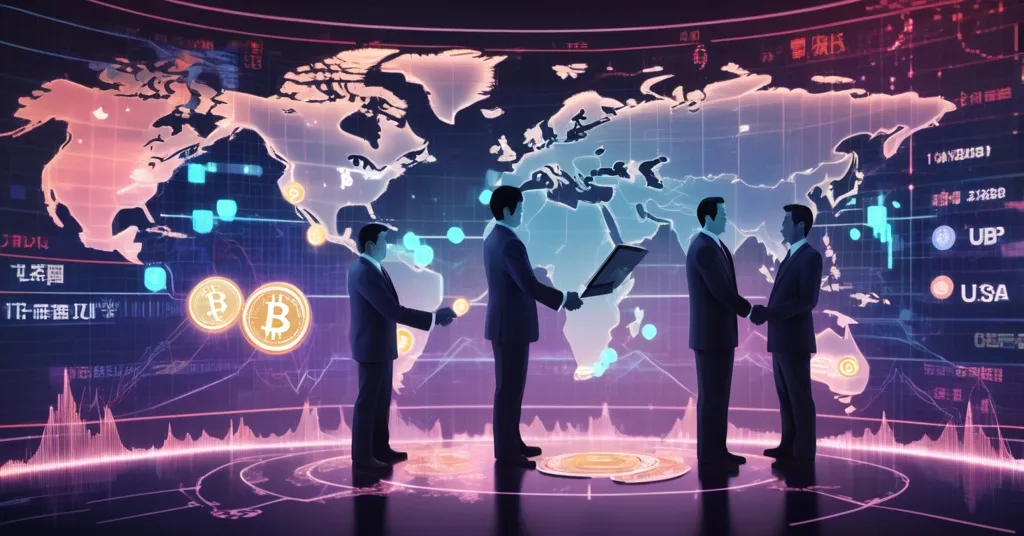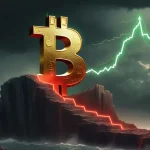Trump’s U.S.-Japan Trade Deal: Economic Win or Crypto Catalyst?

Trump’s U.S.-Japan Trade Deal: Economic Triumph or Smoke and Mirrors?
Donald Trump has unveiled what he dubs the “largest deal ever” with Japan, featuring a 15% reciprocal tariff on Japanese exports and lofty promises of economic windfalls for the U.S. But as markets show cautious optimism, the murky details—and some outright bizarre claims—beg the question: is this a genuine step forward or just another headline-grabbing stunt? And could it ripple into the Bitcoin and crypto space? Let’s cut through the noise.
- Deal Snapshot: 15% tariff on Japanese exports, market access for U.S. goods, and a dubious $550 billion investment pledge.
- Market Pulse: Modest upticks in Nikkei 225, S&P 500, and Dow Jones futures.
- Crypto Angle: Trade sentiment and currency shifts could nudge investors toward Bitcoin as a hedge.
Trump took to Truth Social to trumpet this trade agreement with Japan, locking in a 15% tariff on Japanese goods entering the U.S.—a step down from the pre-existing 25% rate on key sectors like autos, which made up 28.3% of Japan’s exports in 2024. This follows weeks of aggressive posturing, including a threat to impose a 25% tariff across the board if no deal was sealed by August 1. Japan, under pressure, has agreed to open its markets to U.S. products like cars, trucks, rice, and agricultural goods. Trump insists this will create “hundreds of thousands of jobs” for Americans, a claim that sounds impressive but lacks any hard facts or timelines to back it up. For those new to trade lingo, a reciprocal tariff means both countries agree to tax each other’s goods at the same rate—in this case, 15%—supposedly to level the playing field.
Now, let’s tackle the head-scratcher: Trump claims Japan will pump $550 billion into the U.S. economy, with the U.S. snagging 90% of the profits. That’s right, ninety percent. To put that investment figure in perspective, it’s roughly the size of Sweden’s annual GDP—massive, even for a heavyweight like Japan, which already holds $1.2 trillion in direct U.S. investments. But here’s the rub: there’s no official documentation or details from the White House, no timeline, and no explanation of how this profit split—essentially how returns from trade or joint ventures are divided—would even work. Japan’s track record as the largest foreign investor in the U.S. makes a big pledge plausible, but without specifics, this reeks of political hype. Is Trump waving a magic wand, or are we missing the fine print?
Japan will inject “$550 billion into the U.S. economy” and the U.S. would “receive 90% of the Profits.” – Donald Trump
Markets, at least, are giving a polite nod. Nikkei 225 futures in Chicago climbed to 40,185 from a close of 39,774.92, with Toyota shares surging 11% and Honda up 8%. U.S. markets mirrored this tepid enthusiasm, with S&P 500 futures rising 0.2% and Dow Jones futures gaining 99 points. Even Australia’s S&P/ASX 200 and Hong Kong’s Hang Seng futures edged higher. But don’t break out the confetti—investor attention is fractured, with tech earnings from giants like Alphabet and Tesla looming, alongside U.S. housing data painting a grim picture of unaffordability. This trade deal, as seen in recent market reactions, is just one piece of a chaotic economic puzzle.
Tariff Tangle: Who’s Really Winning?
Not everyone’s cheering. U.S. automakers, via the American Automotive Policy Council (representing GM, Ford, and Stellantis), are downright livid, calling it a “bad deal for U.S. industry and auto workers.” Why? Japanese imports now face a reduced 15% tariff, while North American imports from Canada and Mexico still get slapped with a 25% rate. That’s a glaring imbalance, potentially undermining American manufacturers and risking job cuts or factory closures. Detroit isn’t throwing Trump a parade—this “great deal” looks more like a raw one for domestic industry. On the other side, Japanese Prime Minister Ishiba spun the 15% rate as a victory, noting it’s the “lowest among countries with a U.S. trade surplus.” Analysts like Kristina Clifton from Commonwealth Bank of Australia called it a “better outcome” for Japan compared to Trump’s earlier threats, while Kazutaka Maeda of Meiji Yasuda Research Institute suggested it might help Japan dodge a recession. So, is this a win-win, or just a win for one? For more on the tariff impact on Japanese auto exports, the numbers paint a complex picture.
Big Picture: Trade Wars and Economic Friction
Zooming out, this deal fits into Trump’s broader strategy of muscling trade partners with tariffs—think China, Britain, Vietnam, and soon the EU. Japan’s $70 billion trade surplus with the U.S. in 2024, driven by $55 billion in vehicle exports versus a measly $2 billion in return, has long been a sore spot. For context, a trade surplus means Japan sells far more to the U.S. than it buys, often leading to currency imbalances that can devalue the dollar or stoke inflation—issues Bitcoin enthusiasts often point to as flaws in fiat systems. Meanwhile, Ishiba’s domestic political struggles after an election loss might explain Japan’s readiness to concede. But without clarity on that $550 billion or profit splits, this agreement risks being more spectacle than substance. Curious about past dynamics? Check this history of U.S.-Japan trade relations for deeper context.
Historical Echoes: Trade Tensions and Bitcoin’s Rise
Trade friction isn’t new, and its impact on alternative assets like Bitcoin deserves a closer look. During the U.S.-China trade war of 2018-2019, tariff spats and economic uncertainty correlated with Bitcoin price spikes—its value jumped over 200% in 2019 as investors sought hedges outside traditional markets. Why? When trust in centralized economies wavers, decentralized assets shine. Bitcoin’s fixed supply and borderless nature make it a go-to for some during currency volatility—like the yen’s slight firming post-announcement here. While this U.S.-Japan deal isn’t a direct crypto driver, history suggests that global trade instability can push capital into digital currencies. Could we see a similar pattern if U.S. automaker backlash or disappointing tech earnings sour market mood? It’s worth watching, and perspectives on how these deals affect global markets shed light on broader implications.
Crypto Connection: Risk and Refuge
For our audience, the indirect ripples of this deal matter most. Positive market sentiment, as seen in those futures gains, often fuels risk-on behavior—investors taking bigger gambles on volatile assets like Bitcoin or even altcoins. If U.S.-Japan trade ties stabilize, freeing up capital, some might flow into crypto markets seeking high returns. Conversely, if economic uncertainty grows—say, from U.S. job losses in auto sectors or a broader market dip—Bitcoin’s appeal as a hedge against fiat volatility could strengthen. Currency shifts, even minor ones like the yen’s reaction, historically nudge folks toward decentralized stores of value. But let’s not overplay this: trade deals alone won’t make or break crypto adoption. They’re just one spark in a much bigger fire. For a deeper dive into the impact of tariffs on cryptocurrency markets, the connection is worth exploring.
From a Bitcoin maximalist lens, this is where BTC stands out. Unlike altcoins with shakier fundamentals or centralized finance reliant on government whims, Bitcoin’s unassailable decentralization and capped supply make it the ultimate refuge in economic storms. Altcoins might catch some speculative buzz, and platforms like Ethereum could see DeFi activity if trade boosts tech investment, but Bitcoin remains the king for dodging fiat drama. Still, playing devil’s advocate, if this deal somehow reduces global volatility long-term, it could dampen the urgency for crypto hedges. Less chaos, less Bitcoin appeal—ironic, right?
Skeptic’s Corner: Centralized Deals vs. Decentralized Ideals
As champions of decentralization, we’ve got to ask: does this top-down, government-driven deal reinforce the very centralized control Bitcoin seeks to dismantle? Trump’s style—centralized deal-making with opaque terms—clashes with the ethos of cutting out middlemen. Yet, ironically, the flaws of such agreements, from unverifiable claims to domestic backlash, might highlight why we need borderless, trustless systems like Bitcoin. If trade wars and fiat games push more people to question traditional finance, could this inadvertently fuel the case for financial sovereignty through crypto? It’s a long shot, but not impossible. Some discussions on Trump’s tariff policies and their impact reflect similar skepticism.
Key Questions and Takeaways on the U.S.-Japan Trade Deal
- What does the U.S.-Japan trade deal cover?
It includes a 15% tariff on Japanese exports (down from 25%), U.S. access to Japanese markets for cars and agriculture, and a $550 billion investment claim from Japan with zero concrete details. - Should we buy into the $550 billion investment and 90% profit hype?
Not without proof. No official backing or timelines exist for these numbers, and history shows such grand trade promises often fizzle—smells like political spin over economic reality. - How are markets reacting to this agreement?
With a cautious shrug—Nikkei 225 futures rose to 40,185, Toyota jumped 11%, and S&P 500 futures gained 0.2%, but tech earnings and housing data are stealing the spotlight. - What’s the potential impact on Bitcoin and crypto markets?
Indirectly, positive trade sentiment might drive risk-on capital into Bitcoin and altcoins, while economic or currency uncertainty could boost BTC as a hedge, though it’s not a direct catalyst. - Is this deal a true economic win for the U.S.?
Hard to say. Lower tariffs could spur trade, but U.S. automakers are furious over uneven competition, and unverified claims suggest more noise than substance—classic overpromise. - Could trade policies like this push decentralized finance forward?
Possibly, as centralized trade deals expose systemic flaws, potentially driving interest in Bitcoin and DeFi for those seeking freedom from government-led financial games.
So, where does this leave us? The U.S.-Japan trade deal is a messy mix of potential and skepticism. Reduced tariffs and market access might foster ties, but U.S. industry pushback and absurdly vague investment claims hint at a deal heavy on bravado, light on deliverables. For crypto folks, keep an eye on broader sentiment—economic waves, even from traditional shores, can splash into our space. We’ll keep slicing through the bullshit to bring you the real picture, because blind hype is a sucker’s bet, and we’re here for truth, not fairy tales.



